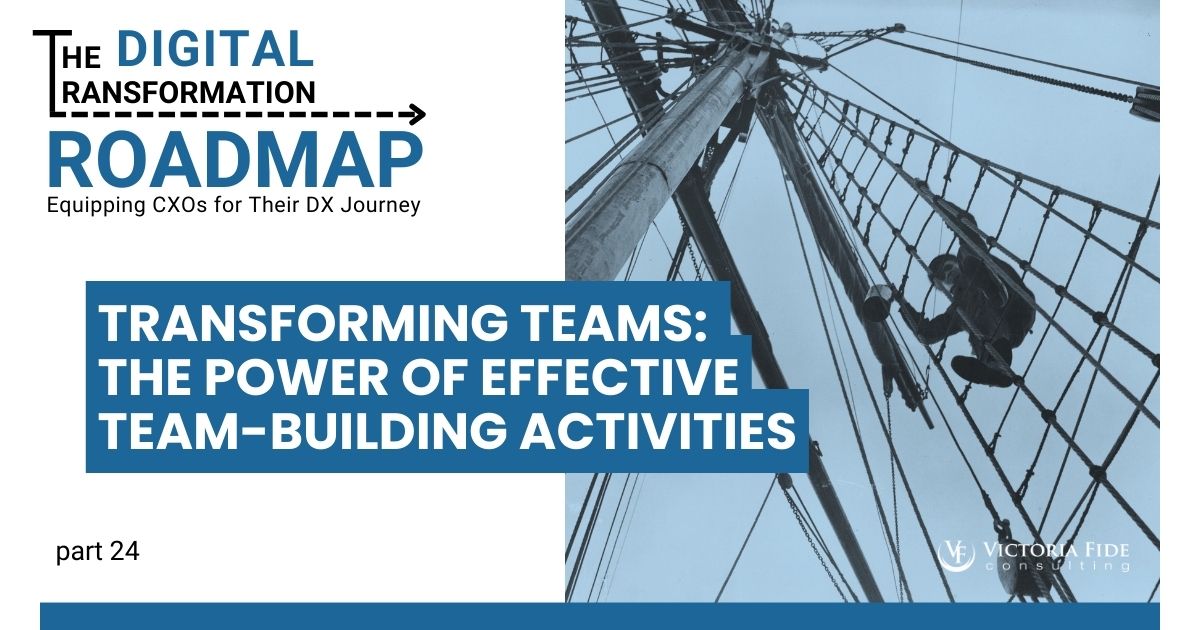
Transforming Teams: The Power of Effective Team-Building Activities
The DX Roadmap series is produced by Victoria Fide Marketing with input and oversight from our leadership team and industry SMEs.
Before international flights and ocean cruise liners were an option, people sailed for weeks or even months to reach their destination. Sailors on these voyages spent many long days and nights in close quarters, often relying on each other for safety during storms, entertainment during the long voyage, and manpower to row onward to their destination when the winds died.
In much the same way, digital transformation (DX) project teams face an arduous voyage across often untested waters. Challenges will arise that will require trust, collaboration, mutual respect, and support to make it through. Team-building activities early in the project’s lifecycle can help create strong bonds and break down the barriers that prevent the types of relationships essential for navigating tough times. By building and nurturing this foundation early on, your project team will be able to support each other and sustain the project no matter what comes.
In this article, we will explore the common barriers that project teams face and how a well-planned team-building activity can overcome those challenges. We will discuss key considerations when planning such activities for your own team and share some of our favorite activities, including those that support remote environments.
Table of Contents
Team-Building Activities: More Than A Trust Fall
People easily underestimate the power of team-building activities. After all, digital transformation initiatives are about technology, so why waste time and money catering in lunch, playing cheesy minute-to-win-it games and practicing trust falls? However, the truth is that team-building activities are actually quite essential because they focus on the most crucial part of the project: the people.
People are the heart of digital transformation initiatives. In a previous article, we discussed how to assemble a high-performing team for your DX project, focusing on placing the right individuals in the right seats. However, even if each individual is highly qualified for their role, it doesn’t guarantee that everyone will effortlessly come together as a cohesive team. Effectively managing a project team while inspiring peak performance requires deliberate and intentional effort.
Breaking Barriers and Building Trust
According to Patrick Lencione’s “5 Dysfunctions of a Team,” a team cannot function without trust. Without a foundation of trust and collaboration, the project team will disintegrate when faced with significant challenges or setbacks, jeopardizing the entire project. Team members often come with various assumptions and preconceptions about others and themselves, which can lead to misunderstandings, conflicts, and a lack of trust.
Building trust begins with understanding one another. Through team-building activities, team members can learn about each other’s backgrounds, strengths, and working styles, creating a deeper understanding and appreciation for one another. These activities can also provide an opportunity to build appreciation for others’ roles by demonstrating what others do, where they are coming from, and what obstacles they may face.
Common barriers that project teams face include:
Cross-functional teams: Bringing individuals from various departments or backgrounds together can lead to conflicting priorities, communication barriers, and lack of understanding. Additionally, many of these people have never worked together.
Remote environments: With the rise of remote work, project teams may not have the opportunity for face-to-face interactions, making it more challenging to build meaningful relationships and trust amongst team members.
External vendors and contractors: Working with external partners can bring unique challenges, such as different working styles, communication methods, and timelines. These differences can lead to misunderstandings and delays if not addressed early on.
Different personalities and workstyles: People have different ways of approaching tasks, communicating, problem-solving, and making decisions. Without understanding and respect for these differences, conflict and miscommunication can arise within the project team. These differences can stem from personality types, cultural differences, or even varied levels within the organizational hierarchy.

Transformation is not easy, but it doesn’t have to be impossible. Take control of your project’s success today and schedule a free 30-minute consultation to find out how Victoria Fide can equip you for transformational success.
Mixed reporting relationships: Often, the project manager is not the direct manager for all members on the project team. As a result, they have to contend with navigating matrixed reporting relationships or competing priorities from external forces while attempting to maintain cohesion and meet project milestones. A team-building activity can go a long way toward establishing these relationships and fostering cohesion.
Long-term projects: Digital transformations sometimes span multiple years, which presents unique challenges such as burnout, employee turnover, and shifting priorities. These challenges can make it challenging to maintain a cohesive team throughout the project’s entirety.
Shifting Team Members: People may come and go at different stages of the project. It’s crucial to ensure that there is continuity, consistency, and camaraderie to keep the project moving forward.
Hosting a team-building activity immediately after the project kickoff is a powerful way to break down these invisible barriers and build trust. Without directly and intentionally addressing these barriers from the beginning, the project may capsize when the waters get rough.
Critical Components of an Effective Team-Building Activity
With a clear understanding of the value and purpose of the team-building activity and the barriers teams face, let’s look at how to leverage this activity to break down barriers and build a foundation of trust.
Facilitate Introductions
Do not assume that everyone knows each other. You might be surprised at how many people have never connected, even if they are long-time employees or work in the same department. Even if they have met, they may have preconceived ideas of each other, and this is a great opportunity to break down those barriers or differences.
Ensure Active Participation
Ensure that all individuals consistently involved with the project actively participate in the activity, and strive for equal engagement from everyone. This allows team members to understand each other’s working styles and thought processes. They may even discover unexpected connections and similarities, fostering a more cohesive and collaborative environment.
Encourage a Cross-Functional Approach
Active collaboration on a team-building activity can help break down silos and foster a cross-functional approach that can carry through the project’s lifecycle. In some organizations, teams are restricted from interacting unless a formal support case or ticket is logged. A cross-functional engagement approach may differ significantly from the methods your team is accustomed to, yet it can enhance efficiency and collaboration.
Reinforce Project’s Importance
If possible, include the project sponsor in the activity. This will demonstrate their commitment to the project and drive home the importance of the team in achieving the project’s success. Additionally, it provides an opportunity for the sponsor to get to know the team and build relationships with them.
Fun and Effective Team-Building Exercises
With the key objectives in mind, it’s time to plan your project’s team-building activity. Catering a lunch or social hour can provide a welcoming atmosphere to set people at ease. Plan a simple “get to know you” ice breaker to give people a chance to share about themselves and their background. Social or party style games provide an opportunity to team up with people they’re unfamiliar with.
Group exercises where people have to work together toward a common goal, such as building a structure with limited resources or participating in an escape room, allow people to practice conflict-resolution, collaboration, and problem-solving skills. Volunteering for a non-profit can allow the team to bond while contributing to a charitable cause.
Options for Remote Environments
With technology enabling increasingly more and more remote or hybrid work, it’s important now more than ever to take intentional steps to foster community and build trust in remote environments. Fortunately, there have never been more options for remote-friendly activities than there are now.
Apps or platforms like Kahoot, PollEV, or even Microsoft Teams enable real-time collaboration and participation across significant distances. Popular games such as Trivial Pursuit, Pictionary, or Jeopardy are easily adapted for on-line participation and can effectively break the ice, encouraging teamwork and helping people to relax and connect. For more adventurous groups, virtual escape rooms or companies like Office DND provide incredibly engaging and memorable remote experiences that team members will bond over for months to come.

The Transformative Impact of Team-Building Activities
Never underestimate the power of team-building activities; they offer much more than just an excuse to order lunch or practice trust falls. Implementing intentional, engaging activities early in a project’s lifecycle can break down barriers and foster trust, creating lasting bonds that will support the team through challenging times.
Building a cohesive team is crucial, but creating an effective cross-functional team presents even greater challenges. The Project Manager, with support from the Project Sponsor, must not only manage the project efficiently but also grasp the interpersonal dynamics and soft skills necessary for nurturing and developing the team. Establishing a foundation of trust and collaboration from the beginning is essential in carrying a project through to successful completion.
By incorporating team-building activities, you can strengthen relationships, improve communication and collaboration, and ultimately increase the chances of project success. Remember to be intentional in your planning and execution, keeping in mind the potential barriers and objectives to ensure a successful team-building activity that benefits both individuals and the project as a whole.
Subscribe to our weekly LinkedIn Digital Transformation Success newsletter and get notified of each new edition.
